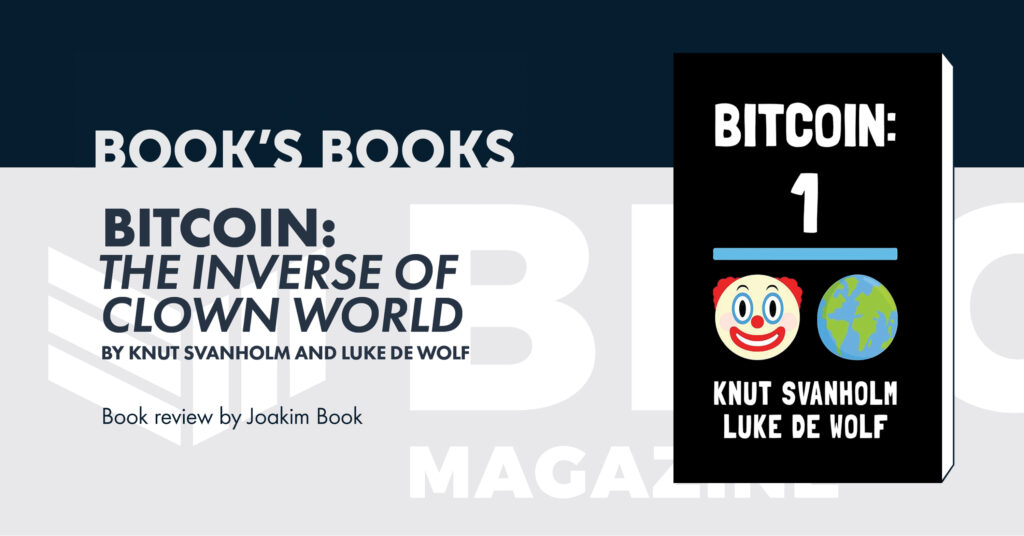Opinion
Why the Media Loves the Worst of Crypto
Published
5 months agoon
By
admin

Not all crypto projects have clear value, however. Memecoins, digital tokens whose value is driven by internet attention rather than tangible use, are divisive — even within crypto circles. For example, dogecoin, a favorite of Elon Musk, has a market value exceeding 94% of companies in the S&P 500, despite lacking a product or business model. Recently, Chris Dixon, at Andreessen Horowitz, even criticized memecoins’ as undermining understanding of the sector’s utility. If one was looking for a reason to argue crypto is a scam, you could find it in pockets of the memecoin world.
Source link
You may like


‘Big Short’ Investor Steve Eisman Derisks, Says Stock Market Volatility Will Be Here for a While


Dow drops over 500 points as UnitedHealth tanks, Fed tensions weigh on markets


Gold Is Still the Safe-Haven King, While Bitcoin Loses Out: JP Morgan


Dogecoin Price Breakout in view as Analyst Predicts $5.6 high


Bitcoin (BTC) Price in Standstill at $85K as Trump Increases Pressure on Fed’s Powell


Ripple acquisition Hidden Road secures FINRA registration

Bitcoin: The Inverse of Clown World by Knut Svanholm and Luke de Wolf, Lemniscate Media, 175 pages, $25.00.
This is a book review from The Mining Issue of Bitcoin Magazine Print. Get your copy here.
—
There is a similarity across the Bitcoin books published this [last] summer: They’re all about self-improvement and spiritual development. As a community, we seem to have moved on from writing about what money is, what it used to be, or how it operates in the modern world — or the specific ways in which bitcoin differs.
Instead, we’re now writing and thinking about life with bitcoin. Bitcoin has a culture, its virtues and values push its users in certain directions. [Aleks] Svetski writes about classical virtues and how they let us live well on a bitcoin standard. Mekhail writes about how to raise kids with intention and a long-term, orange, focus. In Bitcoin: The Inverse of Clown World, Knut Svanholm and his podcast sidekick Luke de Wolf gives us “a journey of introspection and self-improvement” (page 11). This “is a book about you” (page 13); not that different from how [George] Mekhail thinks about parenting.
It’s an unbelievably entertaining and powerful book, with plenty of food for thought about the insanities of our world. The chapter headings are slick, the chapters themselves digestible and relatable. If a measure of a book is how often I laugh, pull out my highlighter, or incessantly send quotes to friends, then Inverse of Clown World receives excellent marks. It’s the perfect combination of light, relaxed reading and hard-hitting punch — sprinkled with a whole jar of humor.

The allure of Inverse is to see that all the madness in the world — political grandstanding, gender dysphoria, the broad moral, fiscal, and political decay — call out for an explanation. Why is it happening? How did it come to this? It seems so obviously irrelevant and so obviously stupid.
Svanholm and de Wolf have an answer, which “is more straightforward than you might think. When the money stops working, everything becomes political and a farce” (page 51). Shockingly, the book’s main suggestion is that moral and political collapse is downstream of the money.
Hurling us straight off the deep end, the opening chapter is praxeology — that arcane, philosophical foundation for all Austrian economics. We then venture from the highest echelons of academic economics and mathematics to popular culture interpretations of Christopher Nolan’s The Dark Knight, to observations of reciprocal altruism in nature and its counterpart in human internet affairs. High and low, indeed.
Some dozen pages in, it feels like reading a textbook-like description of markets and the stylized economic hypothetical known as the prisoner’s dilemma. The authors draw important conclusions from the modern debate about that game-theoretical exercise: “[economist Robert] Axelrod’s findings emphasized the importance of being friendly and forgiving, but also appropriately retaliatory” (page 19). “The balance between self-interest and cooperative behavior is crucial in the game of life, where decisions shape futures” (page 21).
What that has to do with Clown World is a little unclear, and indeed we must wait some fifty pages to get an inkling of what precisely the authors mean by the label. Then again, if you’ve read Svanholm before or listened to the Bitcoin Infinity Show at all — or, you know, not been cave-bound for the last decade-plus — you have a pretty good idea.
Several descriptions are broad-stroke, which is understandable when you try to capture something roughly meaning “everything stupid”. It’s the desire for free lunches (page 41). It’s where “pleasing bureaucrats becomes increasingly profitable, while providing as much value as possible to your fellow man becomes increasingly futile” (page 50). Clown World directly follows from a political money, “which makes people focus on totally arbitrary issues” (page 65); indeed, most so-called societal problems aren’t even problems. Clown World is equality-focused (page 101). In contrast, Bitcoin is fair, honest, and meritocratic. At the very end of the book, we learn that “Clown World is a byproduct of people not taking responsibility”. From that definition it quickly follows, via self-reflection and better “mental software”, that “Taking responsibility for your actions is the only thing that can make the whole damn circus disappear” (page 163):
”Success in the Bitcoin world comes from providing value to your fellow human beings, not mass theft or political manipulation. Everything Divided by 21 Million equals the inverse of Clown World.”
There is no doubt in my mind that Clown World is indeed disappearing, pulling away its most ardent proponents and last, bitter beneficiaries kicking and screaming. Messrs Svanholm and de Wolf think something similar:
”things such as Bitcoin ATMs will look as ridiculous as phone booths in the not-too-distant future. […] it’s not only the ATMs that will fall into obsolescence. Everything in the Jurassic fiat currency world is on the brink of extinction. Are you a dinosaur or a human being?”
Between the ridiculing of wokeness and climate change worries, we get plenty of advice about screening out noise and guarding one’s time and mind. We get personal chapters about Knut running through the rainy slush of Gothenburg, Sweden, as well as unbelievably lengthy adventures in the Einsteinian spacetime and astrophysics. The far-fetched relevance to Clown World (“our attention also shapes our realities”, page 113) could have been reached without this much extravagance.
We get musings on creativity, stoicism, and what the relationship is between freedom and responsibility. Indeed, “whatever small step you take to increase your personal freedom footprint increases the total level of freedom dioxide in the atmosphere” (page 133).
Why should you read this book at all? It’s simple, really: It’s Knut, it’s funny, and at times it’s pretty inspiring.
Selected quotes:
- “When people know enough about Bitcoin to have stopped worrying about their financial future, they usually care less about how others perceive their words and actions and more about honesty and integrity” (page 53).
- “In a world where correct pronoun assignments, teenaged weather activists, the big game last night, Taylor Swift’s latest boyfriend, and a mostly harmless flu are headline news, it’s easy to see that some force is trying to avert our eyes from the men behind the curtain” (pages 24-25)
- “Clownish political ideas have existed for as long as politics itself. They come in many ways, shapes, and forms, and it can be hard to see their ridiculousness when living among them” (page 36)
Final nugget:
“You’re an absolute winner if you have one more Satoshi this year than last. Zoom out and be patient. Sell your chairs, slay your heroes, and take responsibility for your actions” (page 63).
Disclaimer: Opinions expressed are entirely the author’s and do not necessarily reflect those of BTC Inc or Bitcoin Magazine.

Source link
Opinion
Crypto’s Biggest Barrier to Adoption? It’s Not Regulation — It’s UX
Published
5 days agoon
April 13, 2025By
admin

As the crypto industry matures, much of the focus remains on regulation, custody, and scalability. But in 2025, the biggest barrier to adoption isn’t policy — it’s user experience. Crypto’s interfaces are still too complex for everyday users. From managing seed phrases to deciphering blockchain transactions, onboarding feels more like navigating a maze than joining a financial revolution. Wallets remain fragmented, unintuitive, and risky.
To reach mainstream adoption, the industry must prioritize usability — making wallets and financial tools more accessible — without compromising the core principles of decentralization. Until then, poor UX will continue to hold crypto back.
Vitalik Buterin’s Call for Account Abstraction
Ethereum co-founder Vitalik Buterin has been one of the most vocal proponents for improving the usability of crypto wallets. His critique centers on the fact that wallets are designed with developers, not end-users, in mind. While technical innovations in blockchain security are advancing, wallets often remain rooted in outdated models that prioritize control over ease of use, leaving the average user overwhelmed and vulnerable to mistakes.
Buterin’s proposed solution (EIP-7702), account abstraction, is a breakthrough concept that could reshape how we interact with crypto assets. Account abstraction allows smart contract functionality to be applied to externally owned accounts (EOAs), the most common type of wallet used in crypto. This would enable more intuitive and flexible security mechanisms, such as social recovery, multi-signature support, and customizable authentication methods, without compromising decentralization or self-custody.
At its core, account abstraction decouples the traditional reliance on a single private key for securing assets, creating the potential for much more user-friendly experiences. Rather than expecting users to memorize long and complex seed phrases or manage multi-step transactions, account abstraction can allow for recovery options, automatic transaction approvals, and even the option to delegate certain actions to trusted contacts — without ever losing ownership of the private keys.
A Call for Human-Centered Design in Crypto
Crypto’s UX problem isn’t just about cleaner interfaces — it’s about rethinking design to prioritize human needs. Historically, tools have been built for power users comfortable with seed phrases and command-line interfaces. But for mass adoption, crypto must serve people who’ve never held a private key.
This is where human-centered design becomes essential. Developers must build wallets and tools that are intuitive, context-aware, and focused on user safety. The shift must move from catering to the technically inclined to empowering everyday users who are new to crypto. To succeed, wallets need to embrace the following core design principles:
- Smart Defaults and Progressive Onboarding: Users should not need to dive into settings or security configurations to get started. Newcomers should be able to start using a wallet with minimal friction, but with built-in guidance and the option to unlock more advanced features as they become more familiar with the space. By providing clear default security settings — such as social recovery options and automatic transaction limits — wallets can offer both ease of use and security from the outset.
- Clear, Intuitive Signing Processes: Transaction signing should be straightforward, with clear explanations of what users are agreeing to. If a user is about to approve a transaction that could drain their wallet, this should be prominently displayed in plain language, not buried under hexadecimal codes or complex jargon. Reducing ambiguity in these interactions will help mitigate the risks of scams and human error.
- Social and Multi-party Recovery Systems: Relying solely on seed phrases as a recovery method is an outdated and risky practice. Instead, wallets should adopt social recovery systems, where users can designate trusted parties to help restore access to their wallet in case of lost keys. This approach not only makes wallets more resilient but also adds a layer of user trust and security.
- Built-In Education and Contextual Help: To truly empower users, crypto wallets need to include educational tools directly within the interface. Contextual prompts, tooltips, and interactive tutorials can help users understand the significance of each action they take, without overwhelming them with dense technical documentation.
- Automation with Control: Features like auto-payment for transaction fees or the ability to batch transactions can make using crypto wallets much more intuitive, especially for newcomers. But these features must be balanced with user control. Users should have the final say over transactions, but automation can help reduce some of the cognitive load that crypto novices experience.
The Future of Crypto Is Usability and Security—Without Compromise
As crypto moves forward, the real challenge will be to reconcile usability with the core tenets of decentralization and security. Innovations like account abstraction are promising, but the industry must continue to prioritize human-centered design. The goal should be to design tools that make crypto accessible, secure, and simple — without sacrificing self-custody or decentralization.
The future of crypto will not be determined by how fast blockchains can scale or how complex DeFi protocols can get; it will be defined by whether the average person can use crypto with confidence. Until then, crypto will remain an exclusive tool for developers and enthusiasts, rather than a technology that empowers the masses.
The question is simple: Can crypto be both intuitive and secure, or will it continue to be a space designed only for the technically proficient? The answer will determine whether crypto achieves its promise of financial freedom for all.
Source link


Disclosure: The views and opinions expressed here belong solely to the author and do not represent the views and opinions of crypto.news’ editorial.
Chinese companies are leading the AI arms race. Chinese politician and computer scientist Lou Qinjian said as much, recently commending DeepSeek for their accomplishments: “DeepSeek adheres to an open-source approach and promotes the widespread application of AI technology globally, which contributes Chinese wisdom to the world,” he said.
“Through the rise of companies like DeepSeek, we can see the innovation and inclusiveness of China’s technological development.”
In February, at the Artificial Intelligence Action Summit in Paris, US Vice President JD Vance made clear where the Trump Administration stands on artificial intelligence. He said that, first and foremost, the Trump administration will ensure that American AI technology remains “the gold standard” worldwide and that US companies remain the partner of choice for international companies and foreign countries.
The Vice President argued that excessive regulation in the AI sector would kill the nascent industry, and that the administration would encourage pro-AI growth policies. “And I’d like to see that deregulatory flavor, making its way into a lot of the conversations at this conference,” he said. Vance also made it clear that AI should be free of ideological bias and that “American AI will not be co-opted into a tool for authoritarian censorship.”
Finally, the Trump administration will safeguard a pro-worker growth path for AI so it can create jobs in the United States. Vance also brought up the notion of foreign adversaries weaponizing AI software to rewrite history, surveil users, and censorship. As Vance stated:
“This is hardly new, of course, as they do with other tech. Some authoritarian regimes have stolen and used AI to strengthen their military intelligence and surveillance capabilities, capture personal data, and create propaganda to undermine other nations’ national security.”
He warned conference attendees against partnering with such regimes. “From CCTV to 5G equipment, we’re all familiar with cheap tech in the marketplace that’s been heavily subsidized and exported by authoritarian regimes,” he said. “But as I know, and I think some of us in this room have learned from experience, partnering with them means chaining your nation to an authoritarian master that seeks to infiltrate, dig in, and seize your information infrastructure.”
Under the hood of DeepSeek
DeepSeek shocked global markets in January with low-cost models that made it seem like US companies were now behind in the AI arms race. The AI lowered the costs of developing reliable AIs, proving itself to be a powerful and cost-efficient open-source language model.
It changed the way we view how much capital and computational resources are needed to develop AI. Researchers across the Western world are now left playing catch-up, studying DeepSeek’s technical advances and social implications.
There are clear benefits to DeepSeek. For instance, startups without the deep pockets of Google and OpenAI can now compete in the AI sector. AI models can do more with less in the post-DeekSeep world. The company claims it took a mere $6 million using 2,000 Nvidia H800 graphics processing units (GPUs) versus the $80 million to $100 million cost of GPT-4 and the 16,000 H100 GPUs needed for Meta’s LLaMA 3.
The Hangzhou-based startup’s AI model employs reasoning capabilities that allow smaller models, whereas other AIs have had to employ larger models. It also uses reinforcement learning, eliminating the need for supervised fine-tuning. Moreover, DeepSeek’s multi-head latent attention (MHLA) mechanism decreases memory usage to 5%, down from 13%, in earlier AI methods.
DeepSeek raises privacy concerns and questions regarding data-sourcing and copyright. DeepSeek is open-weighted, not open source. Open source models share the full source code and data, and open weight models share trained weights but not the code. Therefore, the exact source code used to train the models is not available.
Due to DeepSeek’s open weight model, it is unknown what its sources are. This seems to be the way most AI companies operate. DeepSeek made public its R1 training and open weight models, which will allow other AI developers to copy and build on the model, but not its sources.
DeepSeek and geopolitics
A race for AI dominance between China and the US has come into focus, while Russian capabilities on the matter remain a secret. Sberbank—Russia’s largest state-owned bank—has revealed its intentions to collaborate with Chinese researchers on AI projects. Russia and China, which share what they call a “no limits” strategic partnership, have long talked about AI cooperation—including in military applications—but little is publicly known about its depth or scope.
Sberbank, under CEO German Gref, once a Soviet-style former state savings bank burdened by onerous bureaucracy, is today one of Russia’s leading players in artificial intelligence. It released its GigaChat model in 2023. “Sberbank has many scientists. Through them, we plan to conduct joint research projects with researchers from China,” Sberbank First Deputy CEO Alexander Vedyakhin told Reuters.
As the AI arms race heats up, the benefits of open source innovation come to the forefront. Little flowers bursting through the concrete all around the world, coming up with cool tech that is open-sourced and decentralized.
Manouk Termaaten
Manouk Termaaten is the founder and CEO of Vertical Studio AI.
Source link

‘Big Short’ Investor Steve Eisman Derisks, Says Stock Market Volatility Will Be Here for a While

Dow drops over 500 points as UnitedHealth tanks, Fed tensions weigh on markets

Gold Is Still the Safe-Haven King, While Bitcoin Loses Out: JP Morgan

Dogecoin Price Breakout in view as Analyst Predicts $5.6 high

Bitcoin (BTC) Price in Standstill at $85K as Trump Increases Pressure on Fed’s Powell

Ripple acquisition Hidden Road secures FINRA registration

Ethereum Whales Offload 143,000 ETH In One Week – More Selling Ahead?

How Do We Protect Bitcoin From Quantum Computers? Not With A Joke

OKX Goes Live In The US After Setting Up New Headquarters in San Jose, California

Stanford’s AI research lab to use Theta EdgeCloud for LLM model studies

Central African Republic Solana Meme Coin Jumps as President Fuels Rumors of Revival

Will Shiba Inu Price 3x?

Bitcoin Cash (BCH) Gains 4.2%, Leading Index Higher

Bybit shuts down four more Web3 services after axing NFT marketplace

Aptos To Continue Moving In ‘No Man’s Land’ – Can It Reclaim $5?

Arthur Hayes, Murad’s Prediction For Meme Coins, AI & DeFi Coins For 2025

Expert Sees Bitcoin Dipping To $50K While Bullish Signs Persist

Aptos Leverages Chainlink To Enhance Scalability and Data Access

Bitcoin Could Rally to $80,000 on the Eve of US Elections

3 Voting Polls Show Why Ripple’s XRP Price Could Hit $10 Soon

Crypto’s Big Trump Gamble Is Risky

Sonic Now ‘Golden Standard’ of Layer-2s After Scaling Transactions to 16,000+ per Second, Says Andre Cronje

Institutional Investors Go All In on Crypto as 57% Plan to Boost Allocations as Bull Run Heats Up, Sygnum Survey Reveals

Ripple-SEC Case Ends, But These 3 Rivals Could Jump 500x

The Future of Bitcoin: Scaling, Institutional Adoption, and Strategic Reserves with Rich Rines

Has The Bitcoin Price Already Peaked?

A16z-backed Espresso announces mainnet launch of core product

Xmas Altcoin Rally Insights by BNM Agent I

Blockchain groups challenge new broker reporting rule

I’m Grateful for Trump’s Embrace of Bitcoin
Trending

 24/7 Cryptocurrency News5 months ago
24/7 Cryptocurrency News5 months agoArthur Hayes, Murad’s Prediction For Meme Coins, AI & DeFi Coins For 2025

 Bitcoin3 months ago
Bitcoin3 months agoExpert Sees Bitcoin Dipping To $50K While Bullish Signs Persist

 24/7 Cryptocurrency News3 months ago
24/7 Cryptocurrency News3 months agoAptos Leverages Chainlink To Enhance Scalability and Data Access

 Bitcoin5 months ago
Bitcoin5 months agoBitcoin Could Rally to $80,000 on the Eve of US Elections

 Ripple Price4 weeks ago
Ripple Price4 weeks ago3 Voting Polls Show Why Ripple’s XRP Price Could Hit $10 Soon

 Opinion5 months ago
Opinion5 months agoCrypto’s Big Trump Gamble Is Risky

 Altcoins3 months ago
Altcoins3 months agoSonic Now ‘Golden Standard’ of Layer-2s After Scaling Transactions to 16,000+ per Second, Says Andre Cronje

 Bitcoin5 months ago
Bitcoin5 months agoInstitutional Investors Go All In on Crypto as 57% Plan to Boost Allocations as Bull Run Heats Up, Sygnum Survey Reveals


